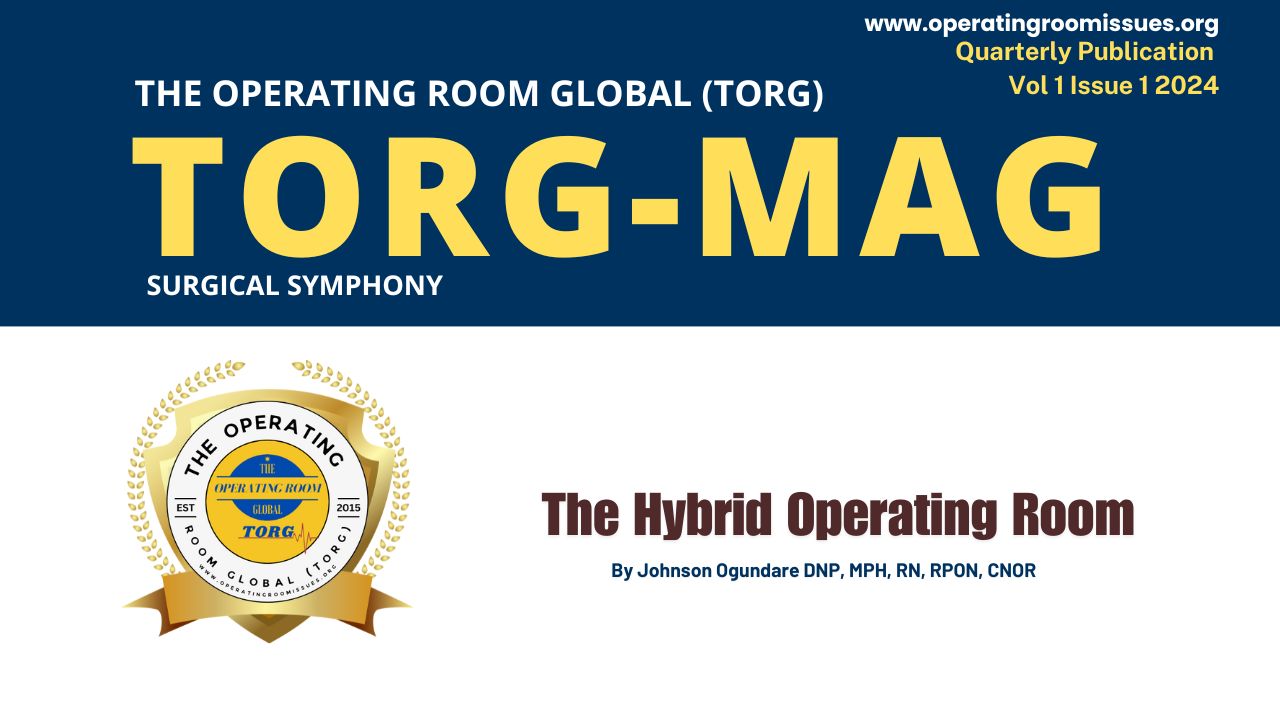TORG-MAG Vol 1 Issue 1, Aug. 2024, PP. 33-34
By Johnson Ogundare DNP, MPH, RN, RPON, CNOR
(Chairman, TORG Executive Council)
Cite this article: Ogundare, J. (2024) ‘The Hybrid Operating Room’, TORG-MAG, Vol. 1, Issue 1, pp. 33-34. Available at: https://torgevents.org/the-hybrid-operating-room/
Introduction

A hybrid operating room (OR) is a specialized healthcare facility that integrates the functionalities of a conventional operating room with state-of-the-art medical imaging and interventional infrastructure.
A hybrid operating room (OR) enables the performance of interventional radiology and operative procedures at the same time, providing a one-stop facility for the treatment of patients with multiple injuries (Khoo et al., 2021).
As an emerging medical innovation, hybrid operating rooms have become widely accepted in the fields of thoracic surgery, neurosurgery, and emergency vascular surgery. They are also gaining popularity for surgeries including gynecological, urological, and orthopedic procedures. A hybrid OR aims to create a versatile and flexible environment for performing both surgical and minimally invasive procedures. Empirical data indicates that the utilization of hybrid operating rooms can lead to enhanced patient outcomes and reduced procedure duration (Clark & Horton, 2023). An optimally designed interdisciplinary hybrid OR should provide a tailored experience that meets the specific needs of every clinician.
Key Features of a Hybrid OR
State-of-the-art Imaging Equipment: The cutting-edge imaging technology in Hybrid ORs includes fluoroscopy, angiography, CT scans, and occasionally magnetic resonance imaging (MRI). These imaging instruments enable surgeons to observe interior structures in real-time during surgery, assisting them in making accurate and well-informed care decisions.
Surgical Capabilities: Hybrid ORs are fully equipped for traditional open surgeries, with all the necessary surgical instruments and equipment. This allows surgeons to seamlessly transition between open surgical procedures and minimally invasive interventions during the same operation.

Integration of Technology: Hybrid ORs often feature integrated technology systems that allow for seamless communication and coordination between surgical and imaging equipment. This integration enhances efficiency and facilitates collaborative decision-making among the surgical team.
Flexibility: The flexibility of a hybrid OR enables a wide range of medical procedures, including cardiac surgeries, vascular procedures, neurosurgery, orthopaedic surgeries, and more. The ability to adapt to different surgical needs makes it a valuable asset in a hospital setting.
Reduced Patient Trauma: The combination of advanced imaging and minimally invasive techniques in a hybrid OR can lead to reduced trauma for patients. Minimally invasive procedures generally result in smaller incisions, less postoperative pain, and faster recovery times compared to traditional open surgeries.
Multi-disciplinary Use: Hybrid ORs frequently bring together surgeons, interventional radiologists, cardiologists, and other specialists, allowing multidisciplinary teams to provide comprehensive patient care and improve outcomes. Ensuring radiation safety for both medical professionals and patients is a crucial factor to consider when incorporating the utilization of hybrid operating rooms (Clark & Horton, 2023).
The implementation of hybrid ORs represents a significant advancement in medical technology, providing a more comprehensive and efficient approach to patient care. It combines the best aspects of traditional surgery with the latest in imaging and minimally invasive techniques, offering patients the benefits of both approaches.
References
- Clark, M., & Horton, J. (2023). Hybrid operating room suites. Canadian Agency for Drugs and Technologies in Health. Accessed December 4, 2023.
- Khoo, C. Y., Liew, T. Y. S., & Mathur, S. (2021). Systematic review of the efficacy of a hybrid operating theatre in the management of severe trauma. World Journal of Emergency Surgery, 16(1). https://doi.org/10.1186/s13017-021-00390-z. Accessed December 4, 2023.
- Web-based Resources for Further Reading
- https://www.getinge.com/int/products-and-solutions/operating-room/hybrid-and-imaging-or
- https://www.gehealthcare.com/specialties/hybrid-or?utm_medium=cpc&utm_source=google&utm_campaign=USC-PS-REG-AlwaysOn&utm_term=&utm_content=12518725892&npclid=CjwKCAiAjrarBhAWEiwA2qWdCJBLN5E0MFakx5GTvBgH82-RI4kKFGf6RxT4lw3_DCHBBcfDy1ZHKxoCpyYQAvD_BwE&gad_source=1&gclid=CjwKCAiAjrarBhAWEiwA2qWdCJBLN5E0MFakx5GTvBgH82-RI4kKFGf6RxT4lw3_DCHBBcfDy1ZHKxoCpyYQAvD_BwE
TORG Magazine (TORG-MAG)
Maiden Edition: Surgical Symphony, Issue 1 Vol 1 Aug 2024
Stay ahead in the field of surgical practice with TORG-MAG, the quarterly publication from The Operating Room Global (TORG).
✓ Fill out the Form Below and submit
